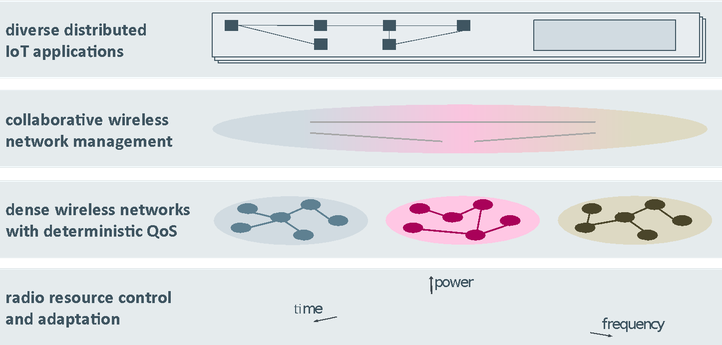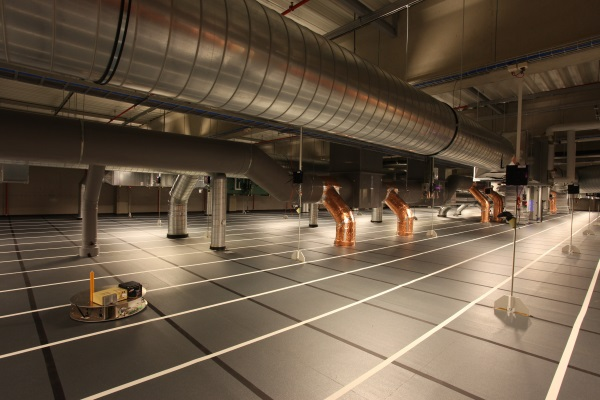Collaborative and Deterministic Networking (CoDeNet)
The increasing density and diversity of connected wireless devices, together with diverging applications requirements, are generating new technological challenges:
- IoT applications leverage more and more on open, standardized IoT stacks and semantics (e.g. IPSO-LWM2M/CoAP/UDP/6LoWPAN/6top/TSCH stack), are typically distributed, and change over time. However, scheduling of IoT network resources remains decoupled from the applications, and as a consequence there exist no solutions for automated reconfiguration upon application layer changes.
- Today’s wireless networks interconnect many heterogeneous devices (TV, smartphone, wearables, smart home solutions…) offering an ubiquitous connectivity platform using heterogeneous networks (Wi-Fi, IEEE 802.15.4, cellular). However, the deployment of the various connectivity platforms still happens in an uncoordinated way making it very difficult to cope with the increasing density of wireless devices.
- Sub-GHz technologies (433/868/915 MHz) have the potential to revolutionize the IoT domain due to their long range, low cost and high energy efficiency. But, current technologies lack the scalability, spectrum management and QoS needed for industry applications. Deployments by competing network operators are further hindered due to cross-network interference.
- With the exponential increase of both high throughput and resource constrained devices, the cost of operating and managing large-scale networks is becoming tremendous. Self-adaptive management and control mechanisms are crucial for addressing this scale.
- Recent advances in chip development, radio hardware platforms and software architectures pave the way towards very flexible wireless networks offering the potential to change the radio and network behavior without without disrupting the operation of wireless networks. However, there is a lack of intelligent strategies for true collaborative sharing of limited spectral resources between independent networks.
- Wireless communications is a catalyst for new intelligent applications such as localization and tracking, providing real-time insights for contextual enablers. However, current localization methods are either inaccurate, too costly, too energy hungry or not applicable for large-scale and challenging environments.
These challenges call for (1) collaborative and intelligent solutions to optimize radio resource usage, and (2) for flexible software/hardware architectures enabling runtime instantiation, (re)configuration and (re)programming of wireless devices . To cope with these challenges, the wireless activities at IDLab are structured in 6 research priorities:
- Application-driven network configurability and programmability: focussing on automatic translation of both standard-based and innovative IoT application dynamics (CoAP, bindings, grouping,…) into network reconfigurations
- High throughput network protocols: designing the new link layer, network and transport protocols for 10Gbps connectivity and more in very dense environments, complex topologies and using a myriad of technologies (Wi-Fi, cellular, 60 GHz, etc.)
- Resource constrained IoT devices & networks: investigating ubiquitous solutions that transparently support a plethora of technologies (e.g., LoRa, DASH7, BLE, IEEE 802.15.4g), targeting co-creation of hardware prototyping and embedded protocol stack design as well as improved interactions with embedded devices.
- Management and control of complex wireless networks: battling the heterogeneous and dense wireless environments of the future by relying on self-adaptive and learning-based approaches.
- Cognitive collaborative radio networks: realizing collaborative radio resource management between independent co-located wireless networks consisting of real-time, reconfigurable software defined radios by applying advanced learning and reasoning strategies.
- Localisation & tracking: localizing people and things in challenging environmental conditions by leveraging on off the shelf wireless technologies (a.o. UWB, Wi-Fi, Zigbee, BLE, Sigfox, DASH7) & through large-scale validations in testbeds.
Staff
Steven Latré, Ingrid Moerman
Chris Blondia, Eli De Poorter, Jeroen Famaey, Steven Latré, Jeroen Hoebeke, Ingrid Moerman, Maarten Weyn
Researchers
Felipe Augusto Pereira de Figueiredo, Jan Bauwens, Ben Bellekens, Johan Bergs, Rafael Berkvens, Noori Bni Lam, Patrick Bosch, Bart Braem, Pieter Becue, Miguel Camelo, Enri Dalipi, Spilios Giannoulis, Glenn Daneels, Stijn Denis, Tom De Schepper, Glenn Ergeerts, Jetmir Haxhibeqiri, Pedro Isolani, Irfan Jabandžić, Xianjun Jiao, Bart Jooris, Abdulkadir Karaagac, Tarik Kazaz, Girum Ketema, Merima Kulin, Bart Lannoo, Wei Liu, Vasilis Maglogiannis, Michael Mehari , Ruben Mennes, Esteban Municio, Dries Naudts, Daan Pareit , Matteo Ridolfi, Jen Rossey, Peter Ruckebusch, Bart Sas, Vincent Sercu, Adnan Shahid, Amina Sljivo, Kathleen Spaey, Bart Spinnewyn, Dragan Subotic, Le Tian, Wim Torfs, Jo van Damme, Floris Van den Abeele,Daniel van den Akker, Jeremy Van den Eynde, Jono Vanhie-Van Gerwen, Ensar Zelikovic
Projects
- FP7 FLEX: FIRE LTE testbeds for open experimentation
- FP7 FORGE: Forging online education through FIRE
- H2020 WiSHFUL: Wireless Software and Hardware platforms for Flexible and Unified radio and network controL
- H2020 eWINE: elastic Wireless Networking Experimentation
- H2020 Flex5GWare: Flexible and efficient hardware/software platforms for 5G network elements and devices
- H2020 ORCA: Orchestration and Reconfiguration Control Architecture
- ARTEMIS DEWI: Dependable Embedded Wireless Infrastructure
- ITEA2 FUSE-IT: Facility Using smart Secured Energy & Information Technology
- MoniCow: More Efficient Cattle Monitoring Through an Advanced Data System
- HYCOWARE: Hybrid Connected Warehouses
- SafeDroneWare: An architecture and framework for safe and autonomous UAV applications
- ICON CONAMO - Continuous Athlete Monitoring
- ICO SELVIE
- FWO/SBO SAMURAI: Software Architecture and Modules for Unified RAdIo control
- FWO/SBO SMILE-IT
- GOA Disposable and biodegradable wireless networks for extreme conditions
- ICON SHIFT-TV
- ICON iFEST - improved festival experience through wireless technology
- ICON LUNAR - Retail industry localization based on ultra wideband technology
- VIS Mechatronics 4.0 - Towards connected, autonomous industrial machines
- Interreg Smart Tooling - Smart tooling for the process industry
- H2020 Synchronicity
- City of Things platform
Key publications
- Merima Kulin, Carolina Fortuna, Eli De Poorter, Dirk Deschrijver, Ingrid Moerman, “Data-Driven Design of Intelligent Wireless Networks: An Overview and Tutorial”, Sensors 2016, 16(6), 790, doi: 10.3390/s16060790
- Bart Jooris, Jan Bauwens, Peter Ruckebusch, Peter De Valck, Christophe Van Praet, Ingrid Moerman, Eli De Poorter, "TAISC: a cross-platform MAC protocol compiler and execution engine", Computer Networks, doi:10.1016/j.comnet.2016.03.027 (2016)
- Le Tian, Steven Latré, Jeroen Famaey. Evaluation of the IEEE 802.11ah Restricted Access Window Mechanism for dense IoT networks. Seventeenth International Symposium on a World of Wireless, Mobile and Multimedia Networks (WoWMoM), Ciombra, Portugal, 2016. UA ID: c:irua:134284
- T. Van Haute, E. De Poorter, F. Lemic, V. Handziski, N. Wirstrom, T. Voigt, A. Wolisz, I. Moerman, “A benchmarking platform for indoor localization solutions”, IEEE Communications magazine, 2015, Vol 53 (9), pages 126-133
- Isam Ishaq, David Carels, Girum K. Teklemariam, Jeroen Hoebeke, Floris Van den Abeele, Eli De Poorter, Ingrid Moerman and Piet Demeester, “IETF Standardization in the Field of Internet of Things (IoT): A Survey”, Journal of Sensors and Actuator Networks, 2(2), 2013, pp. 235-287, doi:10.3390/jsan2020235
- Maarten Weyn, Glenn Ergeerts, Rafael Berkvens, Bartosz Wojciechowski, Yordan Tabakov “DASH7 alliance protocol 1.0 : low-power, mid-range sensor and actuator communication”, IEEE Conference on Standards for Communications and Networking (CSCN), OCT 28-30, 2015, Tokyo, JAPAN - ISBN 978-1-4799-8927-0 - New york, Ieee, (2015), p. 54-59
- Esteban Municio, Steven Latré, “Decentralized Broadcast-based Scheduling for Dense Multi-hop TSCH Networks”, MobiArch - MobiCom workshop (2016)


